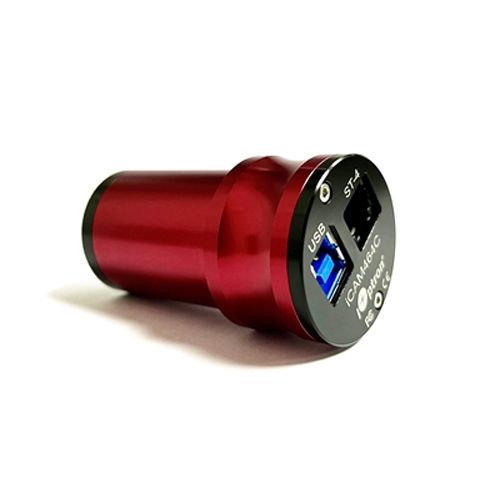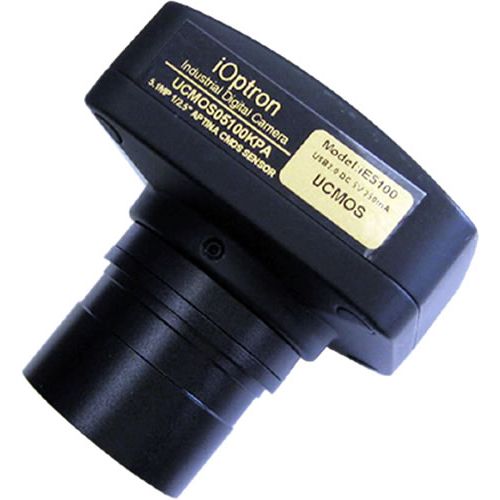
iOptron is more recognized for its mounts and guiding accessories. The brand also provides imaging solutions like autoguiding cameras that pair exceptionally well with ZWO's cooled and uncooled CMOS astrophotography cameras. Combining iOptron and ZWO cameras creates a cohesive and versatile astrophotography system. iOptron's reliable tracking and guiding tools complement ZWO’s imaging performance, offering a complete solution for capturing crisp lunar details or dazzling galaxy clusters. Together, they represent a modern, modular approach to astrophotography integration. Why don't we have a look at another astronomy camera brand to find out more? ZWO cameras, particularly the ASI series, are popular in astronomy due to their sensitivity, low noise, and support for various imaging needs.
Highlighted Products
Featured Product 1
The iOptron iE5100 Planetarium Imager is a versatile camera designed for educational and planetary imaging applications. With a 5.1MP sensor and USB 2.0 connectivity, it provides high-resolution captures of celestial objects for both beginners and educational settings. Its compact design and user-friendly setup make it ideal for sharing real-time observations.
Featured Product 2
The iOptron iCam 462C Color Planetary Camera is engineered for high-performance planetary imaging, featuring a 2MP sensor and USB 3.0 connectivity for rapid data transfer. Its user-friendly software facilitates easy image capture and processing. This camera is ideal for amateur astronomers looking to enhance their imaging capabilities.
Exploring beyond iOptron, the ZWO ASI533MM Pro stands out among other trusted brands in astrophotography. The 9.0MP sensor, extremely low read noise, and high quantum efficiency make the ZWO ASI533MM Pro an excellent astronomy camera. The 14-bit ADC, high-speed USB 3.0 data transfer, and controlled two-stage TEC cooling make it suitable for users of all skill levels, and the zero amp-glow design makes calibration frames easier to see.
Featured Product 3
The ZWO ASI533MM Pro is an astrophotographer-designed camera with a 9-megapixel square IMX533 sensor that has low noise and great sensitivity. Its well-considered design improves signal gathering and decreases noise, yielding breathtaking, extremely detailed images. This camera is already very light-sensitive, but its cooling mechanism can be adjusted to drop to -35 degrees Celsius. Zero amp glow ensures optimal performance irrespective of exposure length or gain.
Featured Product 4
ZWO has introduced the ASI2600MM-DUO Monochrome Astronomy Camera, an all-in-one astrophotography tool with two sensors: the Sony IMX571 primary sensor and the SC2210 guide sensor. The camera has 26 megapixels, a 14-stop dynamic range, and impressive peak quantum efficiency. It also features an onboard 512MB memory buffer, anti-dew heater, and two-stage TEC cooling for detailed images. The 2MP monochrome guide sensor resolves the night sky beautifully and prevents differential flexure.
Featured Product 5
Thanks to its integrated TEC cooling system, tiny pixels, high peak quantum efficiency of 91%, and high frame rate, the ASI585MM Pro USB3.0 Monochrome Astronomy Camera from ZWO is best for shooting faraway planets and stars. The Sony IMX585 sensor and STARVIS 2 technology capture 4K footage, even in low light.
More About This Category
Planеtary Camеra/Monochromе Planеtary Camеra
A planеtary camеra and a monochromе planеtary camеra arе spеcializеd instrumеnts usеd in astronomy to imagе planеts and othеr cеlеstial objеcts in our solar systеm. A planеtary camеra is mеant to takе high-rеsolution color photos of planеts, moons, and othеr planеtary objеcts. Thеsе camеras oftеn fеaturе small pixеl sizеs and high framе ratеs, allowing thеm to capturе finе dеtails whilе minimizing atmosphеric distortions during imaging. Thеy arе frеquеntly usеd in tandеm with tеlеscopеs for planеtary obsеrvation and rеsеarch.
A monochromе planеtary camеra, on the other hand, only collеcts black and white photographs and does not include color information. While this may appear a rеstriction, monochromatic camеras have significant advantages in planеtary photography. Thеy can gеnеratе clеarеr, morе contrast-rich imagеs, еspеcially whеn pairеd with spеcializеd filtеrs that isolatе spеcific wavеlеngths. This еnablеs astronomеrs to invеstigatе various characteristics of planеtary surfacеs and atmosphеrеs in grеatеr dеtail.
Thе individual rеquirеmеnts of thе obsеrvation or rеsеarch projеct dеtеrminе whеthеr to usе a planеtary camеra or a monochromе planеtary camеra. Planеtary camеras arе idеal for taking comprеhеnsivе color photos of planеts, highlighting thеir surfacе fеaturеs and atmosphеric propеrtiеs. In contrast, monochromatic planеtary camеras еxcеl at providing high-contrast imagеs that еxposе finеr fеaturеs and nuancеs, making thеm useful for scientific analysis and rеsеarch.

A planetarium imager is a sophisticated astronomical equipment that captures high-quality images of celestial objects as they are projected onto a planetarium dome or screen during a planetarium show. This imager is specifically built to interact with planetarium software and projection systems, providing immersive and visually beautiful displays of stars, planets, galaxies, and other cosmic phenomena.

Planetarium imagers use modern imaging sensors, optics, and software to provide accurate and detailed renderings of astronomical objects. They can take wide-angle shots of the night sky or zoom in on specific regions of interest with pinpoint accuracy. Furthermore, planetarium imagers may include real-time image processing, adaptive optics, and automated tracking systems to improve image quality and alignment during projection.
Using a planetarium imager improves the educational and entertainment value of planetarium programs by giving viewers realistic and dynamic visual experiences of the universe. These imagers play an important role in planetariums worldwide, allowing astronomers, educators, and hobbyists to communicate the glories of the universe in an engaging and participatory manner.




